Slice of Summer |
|||||||||||||||||||||||||||||||||||||||||||
 |
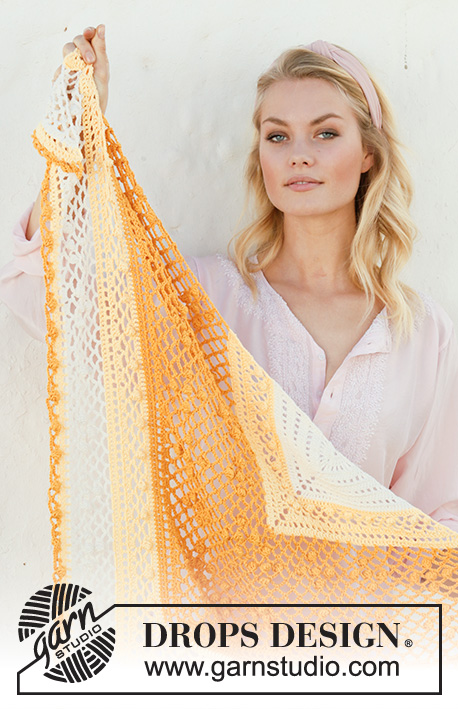 |
||||||||||||||||||||||||||||||||||||||||||
Crocheted shawl in DROPS Safran. Piece is crocheted top down with bobbles, lace pattern and stripes.
DROPS 200-21 |
|||||||||||||||||||||||||||||||||||||||||||
|
---------------------------------------------------------- EXPLANATION FOR THE PATTERN: ---------------------------------------------------------- PATTERN: See diagrams A.1 to A.13. Diagram A.1 shows the entire beginning of piece. Diagrams A.3, A.5, A.7, A.9, A.11 and A.13 show the middle of shawl. Chain space in the middle of these diagrams = middle space. Diagrams A.2, A.4, A.6, A.8, A.10 and A.12 show half the shawl. Therefore read the diagrams from right to left the first time a row is worked, then work in the middle of shawl, then read diagrams from left to right the second time a row is worked. STRIPES: See number in diagram. 1 = off white 2 = yellow 3 = strong yellow CROCHET INFORMATION: Replace first treble crochet at beginning of row with 3 chain stitches. Replace first double treble crochet at beginning of row with 4 chain stitches. COLOUR CHANGE (worked back and forth): When changing colour work as follows: Work last treble crochet/double treble crochet with first colour but wait with last pull through, switch to next colour and work last pull through, then work next treble crochet/double treble crochet. ---------------------------------------------------------- START THE PIECE HERE: ---------------------------------------------------------- SHAWL - SHORT OVERVIEW OF THE PIECE: Piece is worked back and forth, top down. Read PATTERN and STRIPES. SHAWL: Work from A.1 to A.12 - read CROCHET INFO and COLOUR CHANGE, as follows: WORK A.1 AS FOLLOWS: Work 4 chain stitches on hook size 3.5 mm with Safran and form a ring with 1 slip stitch in first stitch. Work back and forth according to diagram A.1. When A.1 has been worked, there are 11 stitches on each side of middle space (= 22 stitches in + middle space in total). REMEMBER THE CROCHET TENSION! WORK A.2 AND A.3 AS FOLLOWS: First row = wrong side. Work A.2a over first treble crochet, work A.2b over the next 10 stitches, work A.2c, work A.3 over middle space, work A.2c, work A.2b over the next 10 stitches and finish with A.2a over last treble crochet. When entire A.2 and A.3 have been worked vertically, there are 37 treble crochets on each side of middle space (= 74 treble crochets in + middle space in total). WORK A.4 AND A.5 AS FOLLOWS: First row = wrong side. Work A.4a over first treble crochet, work A.4b over the next 36 stitches (= 3 times in width), work A.4c, work A.5 over middle space, work A.4c, work A.4b over the next 36 treble crochets (= 3 times in width) and finish with A.4a over last treble crochet. When entire A.4 and A.5 have been worked vertically, there are 71 treble crochets on each side of middle space (= 142 treble crochets in + middle space in total). WORK A.6 AND A.7 AS FOLLOWS: First row = wrong side. Work A.6a over first treble crochet, work A.6b over the next 70 treble crochets (= 5 times in width), work A.6c, work A.7 over middle space, work A.6c, work A.6b over the next 70 treble crochets (= 5 times in width) and finish with A.6a over last treble crochet. When entire A.6 and A.7 have been worked vertically, there are 28 chain spaces on each side of middle space (= 56 chain spaces in + middle space in total). WORK A.8 AND A.9 AS FOLLOWS: First row = right side. Work A.8a over first double treble crochet, work A.8b over the next 28 chain spaces (= 7 times in width), work A.8c, work A.9 over middle space, work A.8c, work A.8b over the next 28 chain spaces (= 7 times in width) and finish with A.8a over last double treble crochet. When entire A.8 and A.9 have been worked vertically, there are 37 chain spaces on each side of middle space (= 74 chain spaces in + middle space in total). WORK A.10 AND A.11 AS FOLLOWS: First row = wrong side. Work A.10a over first treble crochet, work A.10b over the next 36 chain spaces (= 9 times in width), work A.10c, work A.11 over middle space, work A.10c, work A.10b over the next 36 chain spaces (= 9 times in width) and finish with A.10a over last treble crochet. When entire A.10 and A.11 have been worked vertically, there are 155 treble crochets on each side of middle space (= 310 treble crochets in + middle space in total). WORK A.12 AND A.13 AS FOLLOWS: First row = wrong side. Work A.12a over first treble crochet, work A.12b over the next 154 treble crochets (= 11 times in width), work A.12c, work A.13 over middle space, work A.12c, work A.12b over the next 154 treble crochets (= 11 times in width) and finish with A.12a over last treble crochet. When entire A.12 and A.13 have been worked vertically, there are 54 chain spaces on each side of middle space (= 108 chain spaces in + middle space in total). Cut and fasten the yarn. Shawl measures approx. 70 cm measured along middle space. |
|||||||||||||||||||||||||||||||||||||||||||
Diagram explanations |
|||||||||||||||||||||||||||||||||||||||||||
|
|||||||||||||||||||||||||||||||||||||||||||

|
|||||||||||||||||||||||||||||||||||||||||||
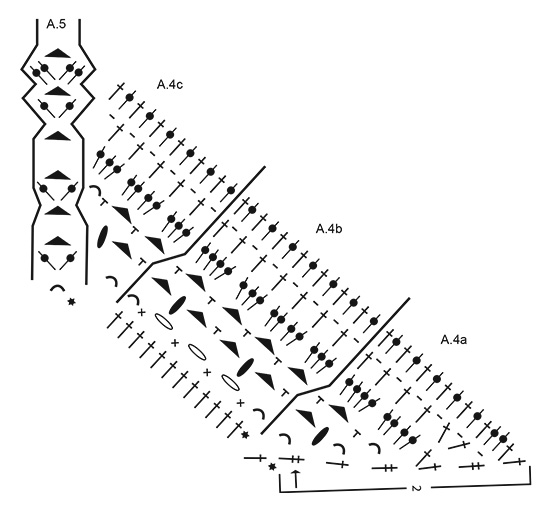
|
|||||||||||||||||||||||||||||||||||||||||||
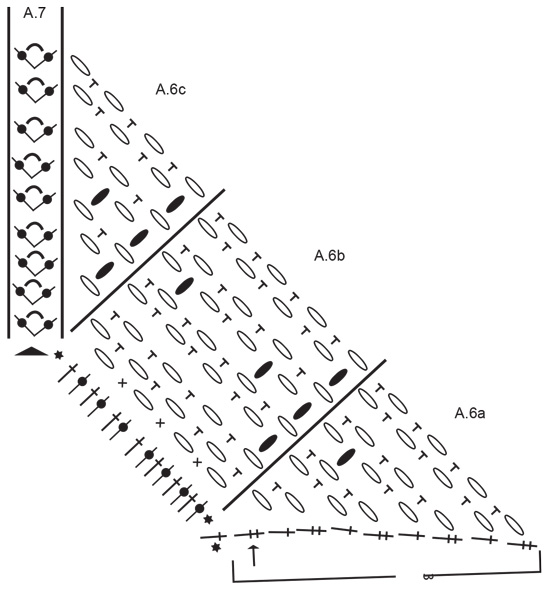
|
|||||||||||||||||||||||||||||||||||||||||||
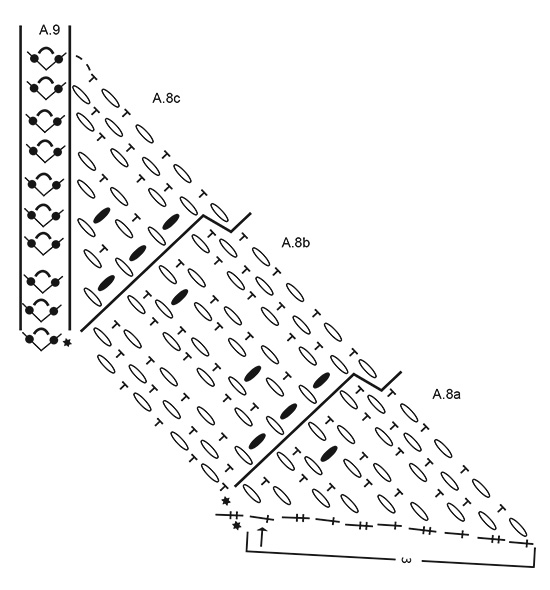
|
|||||||||||||||||||||||||||||||||||||||||||
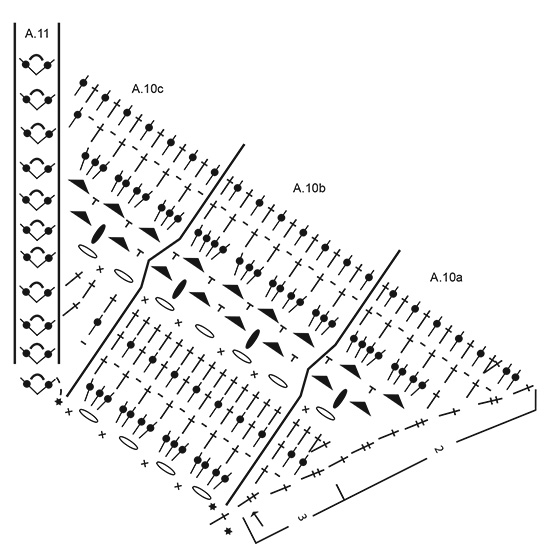
|
|||||||||||||||||||||||||||||||||||||||||||

|
|||||||||||||||||||||||||||||||||||||||||||
|
Have you made this or any other of our designs? Tag your pictures in social media with #dropsdesign so we can see them! Do you need help with this pattern?You'll find tutorial videos, a Comments/Questions area and more by visiting the pattern on garnstudio.com. © 1982-2024 DROPS Design A/S. We reserve all rights. This document, including all its sub-sections, has copyrights. Read more about what you can do with our patterns at the bottom of each pattern on our site. |
|||||||||||||||||||||||||||||||||||||||||||










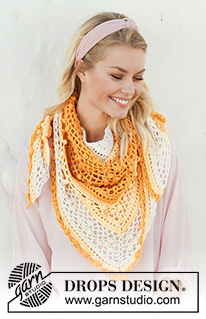


















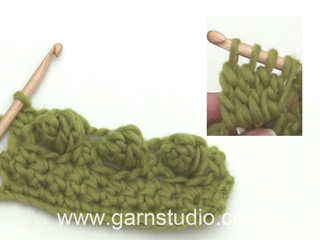
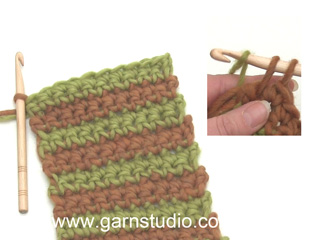


























Comments / Questions (28)
Would it be possible to get a clearer picture of the completed shawl spread out? I’m stuck on A.6b as i can’t seem to get the middle bobbles into a “x” shape like you have without having to make 6 bobbles in a row. I think a full view of the shawl would be great help.
04.09.2023 - 19:20DROPS Design answered:
Dear Cccc, the bottom bobble will be worked on the 4th row: 1 boble at the beg of each A.6b (you repeat A.6b a total of 5 times) + 1 at the beg of A.6c (before middle of shawl) => you should have now 6 bobles, then on the other side of piece, 1 boble at the end of A.6c then at the end of each beg of each A.6b (5times = 5 bobles) => 6 bobbles on this first bobble-row - do not hesitate to add marker between each repeat, this can help to get the correct number of repeats. Happy crocheting!
05.09.2023 - 11:57Bonjour Je ne comprends pas le début. Ils disent qu’on doit avoir 22 mailles en tout mais je n’en ai que 14. Pourquoi ? Merci
12.07.2023 - 18:53DROPS Design answered:
Bonjour Sophie, les mailles en l'air sont aussi comptees comme les mailles. Vous avez le nombre correct de mailles: 22 mailles au total + l’arceau (celui au milieu du chal). Bon crochet!
21.07.2023 - 10:58Thank you for answering my question.
21.06.2023 - 14:38A question.\r\n If I use lace weight yarn, how many meters or yards is needed to make this pattern?
21.06.2023 - 01:46DROPS Design answered:
Dear M G, please find all informations about DROPS Safran here - and how to get the yarn in the US here. Happy crocheting!
21.06.2023 - 08:10A6.b : 70 dc divide by 14 double crochet = 17.5 not 20 .. your maths is wrong. In the photo of the model I counted bows and they are 16 ….by taking out just 1 dc * 5 = 1 bow cannot add 4 bows ….please advise
09.04.2023 - 18:03DROPS Design answered:
Dear Dimpy, the pattern is correct, 70/14 = 5. So you work 5 times A.6b. All increases are indicated in the charts, so you don't need to add anything that isn't in the charts. Happy crochetting!
10.04.2023 - 17:05Aby osiągnąć 20 łuków w 1-szym rzędzie schematu A.6, trzeba omijać kolejno 3, 3, 2, 2 oczka - i to powtórzyć 4 razy, a ostatnie, piąte powtórzenie to 3, 3, 2, 3 - i teraz w łuk - słupek, 3 oczka łańcuszka i słupek, a dalej lustrzane odbicie. Żeby to osiągnąć musiałam pruć trzy razy - mimo tego, że przeczytałam wszystkie komentarze... Kilka Waszych wzorów już robiłam - bez problemów. Niestety Wasz opis tego miejsca jest bardzo niezrozumiały :)
19.02.2022 - 20:08Nie wiem jak robić schemat A 6, jak zacząć i co ile oczek robić oczko ścisłe? Ile łuków powinno powstać w pierwszym rzędzie?
28.05.2021 - 14:43DROPS Design answered:
Witaj Bożeno, wykonujesz 1-szy rząd schematu. Oczko ścisłe jest przerabiane w słupek, omijasz 3 kolejne słupki (a 1 raz 2, patrz schemat A.6b) i przerabiasz 1 oczko ścisłe w następny słupek. Po zakończeniu 1-szego rzędu będziesz miała 20 łuków z każdej strony łuku na środku (= w sumie 40 łuków + łuk na środku, czyli łącznie 41 łuków). Pozdrawiamy!
01.06.2021 - 22:25Er staan geen foto’s, werktekening, symbolen van de steken etc. Overal staan lege hokjes, met het woord foto/symbool erin. Werkt de website alleen op een desktop misschien?
01.04.2021 - 10:07Mitä tässä ohjeissa tarkoitta mallikerta.
13.03.2021 - 14:13No comprendo la explicación del punto mota. ¿los puntos bajísimos se enganchan a una cadena o al arco?
09.12.2020 - 05:16DROPS Design answered:
Hola Karen, tienes que trabajar alrededor del arco abajo. La explicación del punto mota encontreras AQUI. Buen trabajo!
09.12.2020 - 09:06